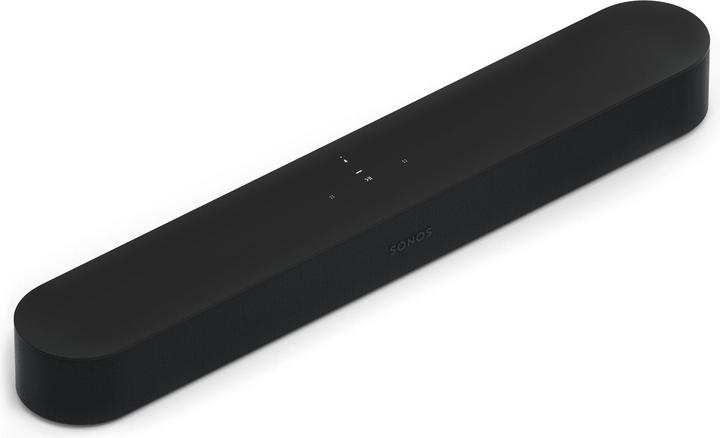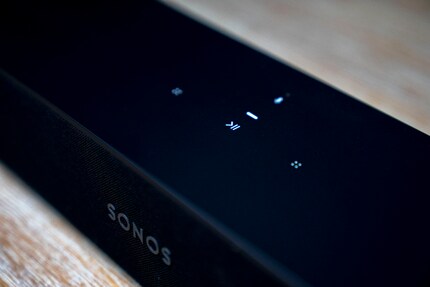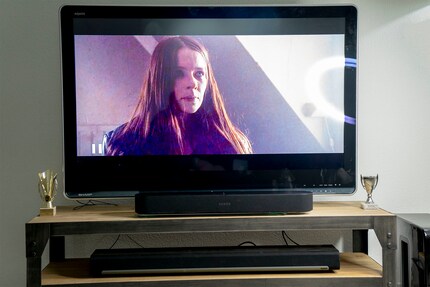

Sonos Beam tested: Big sound for small rooms
The small soundbar from Sonos, the Sonos Beam, is primarily designed to provide good sound in small rooms. The test shows: If you want a home cinema setup, then this is not for you. But otherwise, the smart Beam has a lot to offer.
Before the review begins, a disclaimer: The Sonos Beam I tested is a beta version. While the hardware is identical to the production model, the software is still in beta. So. Now review.
At the media event at which the latest speaker from Sonos was presented, the manufacturer went to great lengths to make the sound sound as good as possible in a loft. Laboratory conditions are nice, but they don't reflect real life. That's why a test is needed. If multi-room systems are to serve niches, then they should also be tested in a niche.
Two days later: My beta access to the app is activated, the Beam can come out of its box. Because nothing works without the app. The Sonos app must be equipped with the appropriate interfaces so that it recognises the speakers and their type.

I won't waste two sentences on the setup now, because if you can't get that right, then you have completely different problems than "I can't set up the box".
Where is my bass?
I have certain songs that I use for the rare audio tests in my flat. These are songs that I know have nice highs and deep bass. I also know how they should sound. For the bass, it's usually the 16bit remix of Noisia's "Machine Gun".
For treble and vocals, this is a track from Mirror's Edge: "Still Alive" by Lisa Miskovsky.
The reason why I use normal, commercially available music is again to test as far away from laboratory conditions and as close to the user's everyday life as possible. That's why you won't find any test tracks or special audio formats in this review. Spotify, BluRay and all the stuff you would find in a household.
"Machine Gun" it is. The four speakers and the three passive bass monitors on the underside of the Beam thunder away. I quickly realise that one thing is missing: the bass. It doesn't thump. It does rumble, but the part where you feel it in your stomach is missing. That's the biggest weakness of the projector. However, I have to say that really good bass - the kind of bass that moves the hairs on your arms - is important to me. It has to be deep and rumbling, like rolling thunder before a storm. I'm also writing this here because I want you to understand my position. Sound experience and preferences in music are as individual as fingerprints, which is why I will provide you with as much additional data as possible. I can adjust the bass with the two equaliser settings. You can't adjust more than bass and treble, but that's enough.
Lisa Miskovsky's voice is clear in the living room of my 3.5-room flat and the treble sounds nice and glassy. In fact, I like the sound so much that I listen to the song again straight away.
I can't fault the sound of the music. As a bass fan, the bass is too weak for me, but a subwoofer has been standard for me since I was a teenager.
No competition for the Playbar
At the media event, the artificial intelligence and adaptability of the speakers was celebrated. The Beam is supposed to recognise whether you are watching a film or listening to music and adjust the sound accordingly. One theory of how the Beam does this: the sound is adjusted depending on which input the sound signal is coming from. The TV sound comes in via HDMI Arc, music comes in via the wifi signal.

First, a comparison with its big sister, the Sonos Playbar. Although it's a little older, much bigger and much heavier, it still puts the Beam in its pocket when it comes to sound. Well, it still has a subwoofer attached, but even without it, the Playbar performs better. Sonos knows this, as it is not marketing the Beam as a competitor to the Playbar, but as an alternative. The Beam is intended for smaller rooms, the Playbar for a large home cinema setup.
However, Sonos cannot completely deny the relationship between the two devices, even if the Beam no longer has an optical in, but everything is done via HDMI Arc or wirelessly via Wifi.
The sound of a film is just right. Whether the voices are really sharper is really difficult to judge. If I listen to the same film scene on the TV without speakers, everything sounds ruined anyway. Nobody really wants to do that to themselves. I'm not surprised that the Sonos Beam sounds better. But even a toaster with audio-out would sound better. However, the Beam is no match for the Playbar, which may be partly due to the fact that the Playbar simply has more space. This is because the bass is outsourced to the subwoofer.
The comparison with the Playbar shows that there is simply more technology and more power in the large soundbar and also why the comparison between Beam and Playbar is somewhat unfair:
Key specs Sonos Playbar
- Six 8 cm aluminium cone midrange drivers
- Three 2.5 cm tweeters with titanium domes
- Each of these nine speakers has its own digital amplifier
Key Specs Sonos Beam
- Five microphones for voice assistants
- One tweeter
- Four woofers covering mids and bass
Nevertheless, the Beam does a good job. The Icelandic film "Metalhead" sounds just as subtle as it should in places and it sounds right when it needs to.
An overwhelming home cinema experience sounds different. Don't get me wrong, if I didn't have my Playbar, I'd be more than happy with the Beam. Actress Þorbjörg Helga Þorgilsdóttir sounds just as vulnerable and angry as she did in the cinema and as she does with the Playbar.
But the Beam is smarter than the Playbar. Alexa is built directly into the small box. This is of little use to us Swiss at the moment, as Amazon's voice assistant has not yet been rolled out in this country, but other voice assistants are set to follow. The Playbar has no built-in microphones, so it's just a speaker and not a smart speaker. I'm still working on the voice assistant thing. Where the Playbar only just produces sound and doesn't adjust the fine settings, the Beam should bring innovation. TV sound and music are optimised depending on what is currently being played.
Podcasts, the supreme discipline?
My test becomes exciting when I want to listen to a podcast. Because the podcasts I like are usually fiction and have background noise. One of my favourite podcast studios, Pacific North West Stories and Terry Miles, aka Nic Silvers, manage to create a very interesting podcast in "The Black Tapes", "Tanis" and "The Last Movie". There's also "Rabbits", but I'm in the middle of Tanis, so I can't just switch.

There are dangerous things
In theory, the test sounds smart: I give the beam something that should confuse it. If my earlier theory of "HDMI equals TV sound, Wifi equals song settings" holds water, then a podcast - i.e. TV audio but without an HDMI signal - should actually be played with the music settings. But right from the intro, it's clear that the Beam knows what it's dealing with. Well done, Sonos.
The room gets smaller, the Beam finds its home
In the meantime, I've moved the Beam from the dining room table to the office, as the room is a bit smaller and there are bookshelves behind my computer setup, plus the world's most comfortable sofa bed to the left of the computer. That's a lot of objects that absorb sound.

It quickly becomes clear that Beam has found its new home in this room. The small office, once probably planned by the architect as a children's room, seems to have been made for the small soundbar. I even like the bass much better here.
Nice that Sonos includes an HDMI cable. This gives me an idea: Is the Beam suitable as a PC speaker? A bit of cable tangling and then some Google searching shows: No. Actually, there would be no reason not to, except that PC HDMI uses quite old standards, while the Beam does not. In other words: PCs use normal HDMI, but Sonos needs HDMI Arc. Even if the hardware connectors and the basic technology are the same, HDMI does not understand a signal from HDMI Arc and vice versa. Well. Then just not. Would have been too nice. I'm open to ideas and suggestions on how to fix this. One suggestion is in the link above, which I will test.
Good for the bedroom, not for the living room
The Sonos Beam is really no competition for the Playbar. It doesn't want to be and it can't keep up. The technology is too weak for that. So if you want to set up a home cinema or fill large rooms with good sound, then you're certainly better off with the Playbar. Sure, it costs more, but not so much more that you need to worry about money.
The Beam shows what it's capable of in small rooms and that's something to be proud of. In small rooms, even the otherwise comparatively weak bass thunders beautifully and warmly. The Beam relies on walls that reflect sound and furniture that absorbs sound. If you can offer the Sonos Beam this space, then you have a very nice speaker.
Journalist. Author. Hacker. A storyteller searching for boundaries, secrets and taboos – putting the world to paper. Not because I can but because I can’t not.


